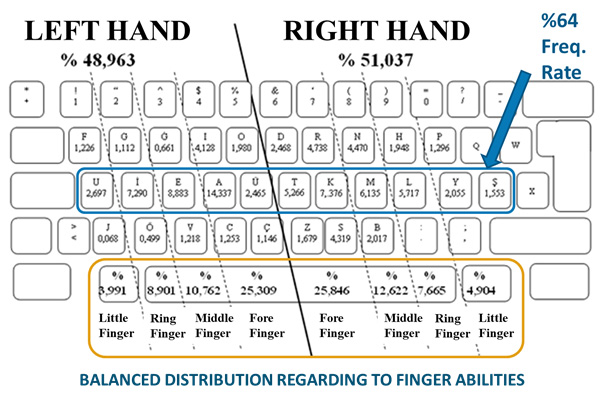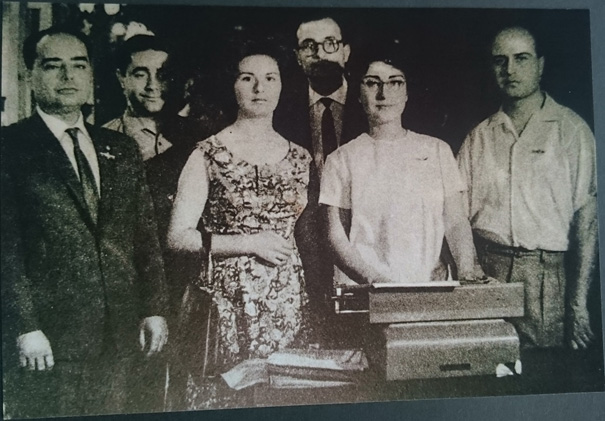Introduction: The Vision of Ihsan Yener
The Turkish Standard Keyboard Layout, often called the F-keyboard, was created in 1955 by Ihsan Yener PhD (1925–2016). Having graduated from the Istanbul Academy of Economics and Commercial Sciences, he started teaching shorthand, typing and vocational courses at Istanbul’s Sultanahmet Commercial High School in 1946.
In the first years of his career, Yener taught typing to Turkish students using various foreign typewriter machines made by companies in different countries. It was a tough situation for students and professionals alike: the typewriters had different layouts, while the professionals could not often access the same layouts when working that they had been taught on at school.
Yener saw a big need for a new, standard layout for the typewriter machines used in Turkish business and education—one developed specifically for the Turkish language and based on scientific research. In 1947, he reached out to the official authorities in the Government to develop this layout. Between 1951 and 1955, a commission worked towards a scientific standard layout for all typewriters in Turkey. Yener was the leader of this commission and did a large amount of research himself to develop the layout. He produced a statistical report of the frequencies of letters in Turkish, based on a collection of 30.000 words. He collaborated with physicians and doctors to observe the bone, nerve and muscle movements of the hands and each finger on them. With his collaborators, he also did X-ray examinations to detect the strongest and weakest fingers. Finally, he used all of this knowledge to develop the optimal keyboard layout specifically for the Turkish language.
The Properties of the F-Keyboard
As the result of these long-term research and development efforts by Yener and the commission, a national keyboard layout for the Turkish language was finally presented and registered by the Government on 20 October 1955. This layout has been called the F-Keyboard in recent decades because the letter in its top-left corner is F. However, it is officially registered as the Turkish Standard Keyboard Layout by the Turkish Standards Institution.
The F-Keyboard’s science-based principles are derived from touch typing (the 10-finger method) and its specific compatibility with the Turkish language. Its main principles are as follows:
- The F-keyboard aims to be the most compatible layout for touch typing in Turkish. It was developed based on the specific phonetic features of the Turkish language (e.g., the repeating structure of vowel–consonant combinations).
- The educational method behind the F-Keyboard provides 100% accuracy with the highest possible speed in typing.
To achieve this, the most used letters were placed on the middle line of the keyboard, under the most used and strongest fingers. The letters were also situated so that each hand is active on the keyboard at almost the same intensity (left hand: 49%, right hand 51%).
You can see the layout of the F-keyboard with the balanced distribution related to finger abilities in the figure below.

Since 1955, the F-Keyboard has provided Turkish writers with the ability to type with extremely high accuracy and speed in the Turkish language. It has thus enabled everyone working in offices to use a much more productive, science-based keyboard, compared with, for example, the regular Qwerty keyboard. Because of its speed and accuracy, the F-keyboard is widely used in all Turkish reporting professions.
The First Championship and Historical Successes
From 1946 on, Ihsan Yener organised regional and national competitions in typewriting. After the invention of his F-Keyboard in 1955, he also started to develop scientific methods in order to train qualified students and professionals. In 1957, he and his students attended the Intersteno Congress and the typewriting competitions in Milan for the first time. Within a decade, his methods and the F-keyboard resulted in 1965 in the emergence of the first Turkish world champion in typewriting, Ece Özbayrak. Since then, Turkish students and reporters have been awarded more than 100 championships. Because of these achievements, the F-Keyboard is widely known as the most scientific and compatible keyboard layout developed for a specific language.

Ihsan Yener (left) with his students.
Educational Milestones
In 1928, the Latin alphabet was adopted for the Turkish language. After that, typewriting education grew rapidly in Turkey, mainly for government offices. The courses were taught in business and secretarial schools managed by the Ministry of Education. After its birth, the F-Keyboard entered the standardised curriculum for high schools and universities. With time, using the keyboard became a great skill for an expanded set of professions, such as reporting, communication, secretarial work, work in legal offices and the notary profession, etc.
In 1954, Ihsan Yener also founded a private education centre in Istanbul, where he trained students to use the F-Keyboard. Since then, he had many opportunities to train students in his unique methods for business—and for the championships. When the first Turkish champion won their award with the F-keyboard, he renamed the education centre “Sampiyon” (Champion). Since then, more than 100,000 students have been trained by his education centre and, after graduating, employed in businesses.
Historical Journey of the F-Keyboard to the Present
The F-Keyboard was developed first for mechanical typewriter machines in the 1950s. It was a golden era for the F-Keyboard and typewriters in general in Turkey, including electrical and electronic ones.
In the 1980s, PCs arrived in Turkey. Because of these imported machines, the Qwerty keyboard was presented as the international standard for computers. The Turkish customs law had standardized the F-Keyboard for typewriters but not for computers. Because of this, initially, the computers did not even support the Turkish alphabet. Since the Government were late to regulate standards for computers, the first keyboard layout was Turkish Qwerty. This resulted in a conflict between the two layouts. Mr. Yener struggled to make the F-Keyboard the only standard for computers, but he did not succeed as well as he wanted.
In 1991, the Turkish Standards Institution presented an updated F-Keyboard layout for all kinds of typing devices. However, it could not be made a compulsory layout for Turkish computers, since thousands of computers had already been imported by the country, and most users were using American or Turkish Qwerty. The F-Keyboard was used mainly by those with typewriters and some specific professionals, such as professional reporters.
Today, the usage rate of the F-Keyboard is only about 5% to 10% in the general population of Turkey. Because of government policies in the 1980s, Turkish Qwerty gained the majority. As a result, national education policies could never introduce the F-Keyboard to, for example, touch-typing education in primary and elementary schools. Today, touch typing with the F-Keyboard is taught at only a few business high schools, along with some juridical and medical colleges and secretarial schools.
Use of the F-Keyboard in Court and Parliamentary Reporting
Turkish shorthand and stenotype methods have not been developed and expanded sufficiently for court reporting. Because of this, the hearings are not reported verbatim. In Turkey, the court reporters serve as assistants to the judges, who prepare summary reports of the sessions. The summary reports include the main points of the hearing and the final decision, dictated by the judge. The hearings are automatically recorded by video cameras but transcribed only when judicially requested.
The Ministry of Justice requires all court reporters to have touch-typing skills, with a minimal speed of 40 words per minute. Higher speeds are not required, since the reporters have to transcribe only the dictation of the judge in the report. However, high accuracy and speed is still very much valued in Turkish court reporting, and many reporters use the F-keyboard. Previously, the F-Keyboard was even made compulsory in Turkish court reporting but, during the last couple of years, the ministry has started to accept Qwerty users in examinations. This decision has been made because of insufficient touch-typing education and the difficulty in hiring people trained on the F-Keyboard.
In the Turkish Parliament, various shorthand methods have been used to make its verbatim reports since the 19th century. Today, it is the only place where Turkish shorthand is still used professionally. The F-Keyboard is often used to transcribe the shorthand minutes, but there are no strict regulations for the keyboard. The objective of the process is to transcribe the reports from the shorthand minutes as quickly as possible and with 100% accuracy, regardless of the keyboard used.
Conclusion
Today, the F-Keyboard faces a challenging situation in Turkey. The general population uses the Qwerty keyboard in personal computers. This has greatly disadvantaged the efficiency of professional typing in Turkey. None the less, big efforts are still being made to adopt touch-typing on the F-Keyboard in the curriculum of all primary and high schools in the country. Its efficiency-aware activists see the keyboard as not only a technical tool, but a cultural and linguistic issue in modern Turkey.
Emrah Kuyumcu works as a real-time captioner in Turkish and as a consultant in touch-typing for the F-Keyboard. He is also the vice-president of Intersteno and Tiro’s webmaster.
References
Intersteno-Turk [The Turkish Group in Intersteno]. www.interstenoturk.org
Turkish Standardization Institute [TSE]. www.tse.org.tr
Yener, Ihsan (1956). Secretary & Dactylographer, vol. 1-7.





Tebrik ederim, faideli ve titiz bir çalışma olmuş.
This makes me so sad to read. English language imperialism wins again, and against a proven competitor which in Turkish beat it hands down.
I have just started learning Turkish, and with it I had to choose a Turkish keyboard on the computer. I chose Turkish-Q because I can already touch type on a QWERTY in English. My right little finger has to do so much work, and of course is now getting very sore. Perhaps I should just train on Turkish-F.